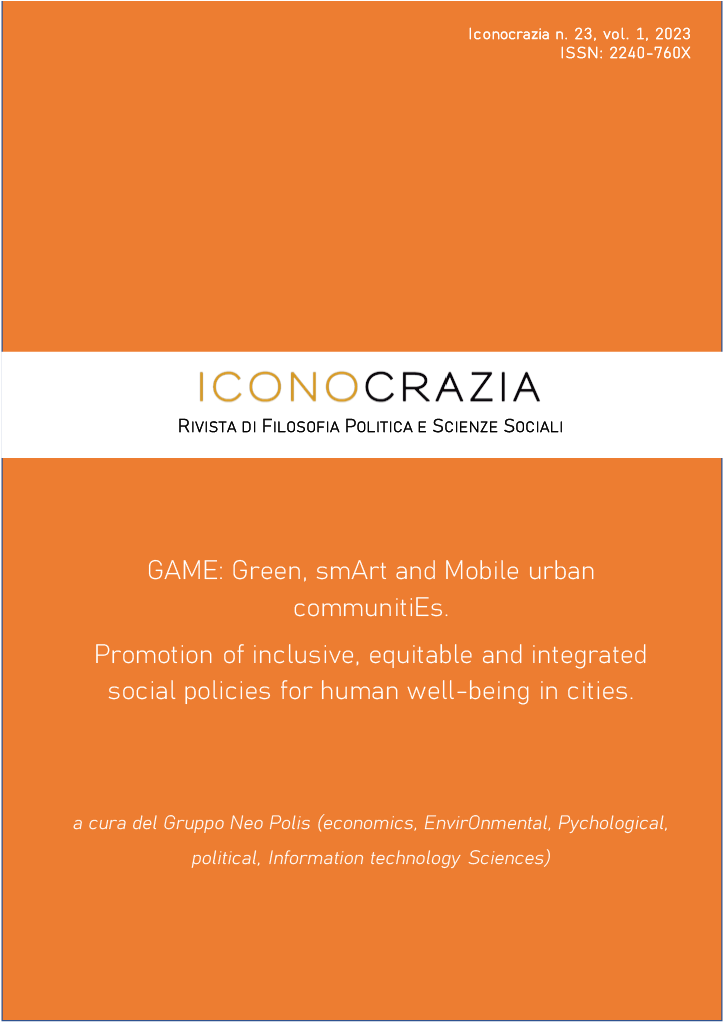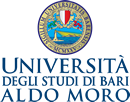Città e destinazioni turistiche più sostenibili: Un’applicazione dell’innovazione tecnologica nei comuni di Bari e Taranto.
DOI:
https://doi.org/10.15162/2240-760X/1845Parole chiave:
Città intelligenti, destinazioni turistiche intelligenti, trasporto sostenibile, innovazione tecnologica, Mobilità come Servizio (MaaS), Smart cities, smart tourism destinations, sustainable transport, technological innovation, Mobility as a Service (MaaSAbstract
Nell’attuale contesto della mobilità urbana, emerge una crescente richiesta di servizi di mobilità sostenibili, flessibili e integrati. Il Green Deal Europeo con lo scopo di fornire trasporti efficienti, sicuri e rispettosi dell'ambiente, ambisce a raggiungere il 55% di riduzioni di gas serra legati al trasporto entro il 2030, e il 90% entro il 2050. In particolare, è il trasporto in ambito urbano a contribuire per il 72% delle emissioni di CO2 provenienti dal trasporto su gomma in Europa. Tutto ciò ha portato negli ultimi anni alla trasformazione delle città in un'ottica smart e al diffondersi di pratiche di mobilità intelligente, dove l'ICT rappresenta una soluzione promettente per raggiungere questi nuovi obiettivi di mobilità. Questo lavoro prende in analisi le importanti caratteristiche di alcune iniziative emblematiche avviate da due città pugliesi, Bari e Taranto, che si stanno distinguendo nel panorama dell’Italia meridionale per le recenti iniziative legate alla Smart Mobility. Questa trasformazione influenza le politiche e le scelte degli abitanti, portando all’emergere di nuovi servizi e strategie, creando così un ambiente urbano nuovo e altamente personalizzato atto a soddisfare le esigenze e le preferenze sia dei residenti che dei visitatori.
In the current context of urban mobility, a growing demand for sustainable, flexible, and integrated mobility services emerges. The European Green Deal, with the scope of providing efficient, safe, and environmentally friendly transport, aims to achieve 55% reductions in transport-related greenhouse gas emissions by 2030, and 90% by 2050. In particular, the European urban transport contributes by 72% of the total CO2 emissions from road transport. This has led to the transformation of cities from a smart perspective and the spread of intelligent mobility practices in recent years, where ICT represents a promising solution to achieve these new mobility objectives.This paper analyses the important characteristics of some emblematic initiatives launched by two Apulian cities, Bari and Taranto, which are standing out in the panorama of southern Italy for their recent initiatives linked to Smart Mobility. This transformation influences policies and choices of inhabitants, leading to the emergence of new services and strategies, thus creating a new and highly personalized urban environment capable of satisfying the needs and preferences of both residents and visitors.
Riferimenti bibliografici
Armenio S., Bergantino A. S., Intini M., & Morone A. (2022). Cheaper or eco-friendly cars: What do consumers prefer? An experimental study on individual and social preferences, Ecological Economics, 193, pp. 107-323.
Arias-Molinares D.; García-Palomares J.C. (2020). The Ws of MaaS: Understanding Mobility as a Service Fromaliterature Review, IATSS, 44, pp. 253–263.
Bergantino A. S., Intini M., & Tangari L. (2021a). Influencing factors for potential bike-sharing users: An empirical analysis during the COVID-19 pandemic. Research in Transportation Economics, 86, https://doi.org/10.1016/j.retrec.2020.101028.
Bergantino A. S., Buongiorno A. & Intini M. (2021b). Mobilità e sviluppo turistico sostenibile. Una prospettiva economica, Carocci.
Bergantino A. S., Buonarota M., Buongiorno A. & Intini M. (2023). Regional multimodal accessibility: Policies and strategies for sustainable tourism destinations in coastal areas, Research in Transportation Business & Management, 48, 100872.
Beutel M. C., Gökay S., Kluth W., Krempels K. H., Samsel C. & Terwelp C. (2014). Product oriented integration of heterogeneous mobility services, in 17th International IEEE Conference on Intelligent Transportation Systems (ITSC), pp. 1529-1534.
Buhalis D., & Amaranggana A. (2015). Smart tourism destinations enhancing tourism experience through personalisation of services. In Information and Communication Technologies in Tourism 2015: Proceedings of the International Conference in Lugano, Switzerland, Springer International Publishing, February 3-6, pp. 377-389.
Caballini C., Olivari E., Gasparini C., Dalla Chiara B. (2023). The Spread of MaaS Initiatives in Europe: The Leading Role of Public Governance Emerging from an Italian Regional Application, Sustainability, n. 15 (18):13413.
Coca-Stefaniak J. A. (2019). Marketing smart tourism cities–a strategic dilemma, International Journal of Tourism Cities, no. 5(4), pp. 513-518.
De Santis R., Fasano A., Mignolli N., & Villa A. (2014). Il fenomeno smart cities, Rivista Italiana di Economia Demografia e Statistica, n. 68 (1), 143.
Estevez E., Lopes N. & Janowski T. (2016). Smart sustainable cities: Reconnaissance study.
Gerboni R.; Caballini C.; Minetti A.; Grosso D.; Dalla Chiara B. (2021). Recharging Scenarios for Differently Electrified Road Vehicles: A Methodology and Its Application to the Italian Grid, Transp. Res. Interdiscip. Perspect, n. 11, 100454.
Goldman T., & Gorham R. (2006). Sustainable urban transport: Four innovative directions, Technology in society, n. 28 (1-2), pp. 261-273.
Habeeb N. J. & Weli S. T. (2020). Relationship of smart cities and smart tourism: an overview, HighTech and Innovation Journal, n. 1(4), pp. 194-202.
Heddebaut O. & Di Ciommo F. (2018). City-hubs for smarter cities. The case of Lille “EuraFlandres” interchange, European transport research review, n. 10 (1), pp. 1-14.
Ivars-Baidal J. A., Celdrán-Bernabeu M. A., Mazón J. N., & Perles-Ivars Á. F. (2019). Smart destinations and the evolution of ICTs: a new scenario for destination management?, Current Issues in Tourism, n. 22 (13), pp. 1581-1600.
Janasz T. (2018). Digital Technologies and Business Model Innovations for Urban Mobility, Paradigm Shift in Urban Mobility: Towards Factor 10 of Automobility, pp. 67-194.
Jittrapirom P., Marchau V., van der Heijden R. & Meurs H. (2018). Dynamic Adaptive Policymaking for Implementing Mobility-as-a Service (MaaS), Res. Transp. Bus. Manag., n. 27, pp. 46–55.
Kim H. M., Sabri S., & Kent A. (2021). Smart cities as a platform for technological and social innovation in productivity, sustainability, and livability: A conceptual framework, in Smart cities for technological and social innovation, Academic Press, pp. 9-28.
La Rocca R. A. (2014). The role of tourism in planning the smart city, TeMA-Journal of Land Use, Mobility and Environment, n. 7 (3), pp. 269-284.
Rudolf, G., Fertner, C., Kramar, H., Kalasek, R., Pichler-Milanovic, N., & Meijers, E. (2007). Smart cities-ranking of european medium-sized cities. Rapport technique, Vienna Centre of Regional Science.
Sochor J. L., Strömberg H., & Karlsson M. (2015). An innovative mobility service to facilitate changes in travel behavior and mode choice, 22nd World Congress on Intelligent Transportation Systems, Bordeaux, October 5-9, 2015.
Surakka T., Härri F., Haahtela T., Horila A. & Michl T. (2018). Regulation and Governance Supporting Systemic MaaS Innovations, Res. Transp. Bus. Manag, n. 27, pp. 56–66.
Vianello M. (2013). Smart cities, Maggioli editore.
Washburn D., Sindhu U., Balaouras S., Dines R.A., Hayes N.M., Nelson L.E. (2010). Helping CIOs Understand “Smart City” Initiatives: Defining the Smart City, Its Drivers, and the Role of the CIO, Cambridge, MA: Forrester Research, Inc.







